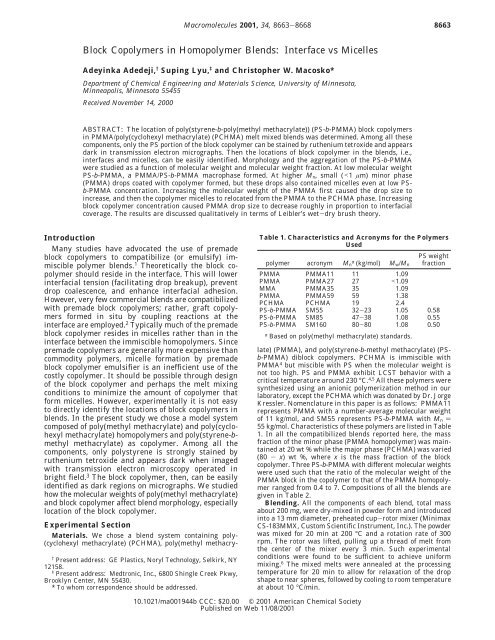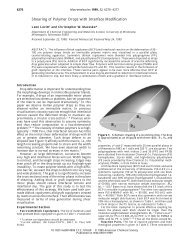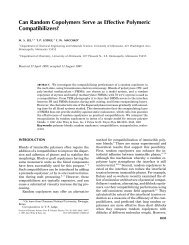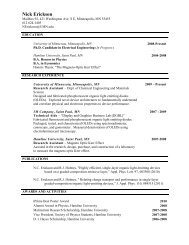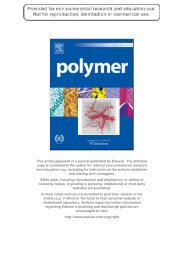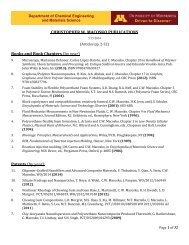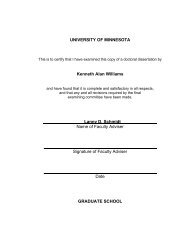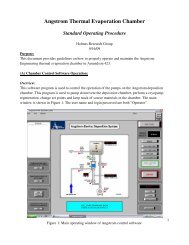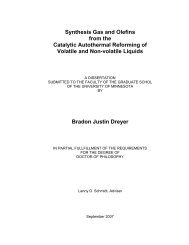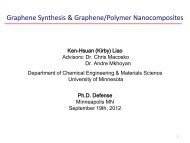Block Copolymers in Homopolymer Blends: Interface vs Micelles
Block Copolymers in Homopolymer Blends: Interface vs Micelles
Block Copolymers in Homopolymer Blends: Interface vs Micelles
You also want an ePaper? Increase the reach of your titles
YUMPU automatically turns print PDFs into web optimized ePapers that Google loves.
Macromolecules 2001, 34, 8663-8668<br />
8663<br />
<strong>Block</strong> <strong>Copolymers</strong> <strong>in</strong> <strong>Homopolymer</strong> <strong>Blends</strong>: <strong>Interface</strong> <strong>vs</strong> <strong>Micelles</strong><br />
Adey<strong>in</strong>ka Adedeji, † Sup<strong>in</strong>g Lyu, ‡ and Christopher W. Macosko*<br />
Department of Chemical Eng<strong>in</strong>eer<strong>in</strong>g and Materials Science, University of M<strong>in</strong>nesota,<br />
M<strong>in</strong>neapolis, M<strong>in</strong>nesota 55455<br />
Received November 14, 2000<br />
ABSTRACT: The location of poly(styrene-b-poly(methyl methacrylate)) (PS-b-PMMA) block copolymers<br />
<strong>in</strong> PMMA/poly(cyclohexyl methacrylate) (PCHMA) melt mixed blends was determ<strong>in</strong>ed. Among all these<br />
components, only the PS portion of the block copolymer can be sta<strong>in</strong>ed by ruthenium tetroxide and appears<br />
dark <strong>in</strong> transmission electron micrographs. Then the locations of block copolymer <strong>in</strong> the blends, i.e.,<br />
<strong>in</strong>terfaces and micelles, can be easily identified. Morphology and the aggregation of the PS-b-PMMA<br />
were studied as a function of molecular weight and molecular weight fraction. At low molecular weight<br />
PS-b-PMMA, a PMMA/PS-b-PMMA macrophase formed. At higher M n, small (
8664 Adedeji et al. Macromolecules, Vol. 34, No. 25, 2001<br />
PMMA M n<br />
(kg/mol)<br />
Table 2. Morphological Characteristics of <strong>Blends</strong> (All Conta<strong>in</strong>ed 20 wt % PMMA)<br />
SM M n<br />
(kg/mol) SM (wt %) D n (µm) D <strong>vs</strong> (µm) Σ/Σ<br />
a 0 comment<br />
11 0 >1 very unstable<br />
11 55 5 macro-phase, micelles <strong>in</strong> PMMA (Figure 2)<br />
11 85 5 0.33 0.44 1.0 drops + micelles <strong>in</strong> PMMA<br />
35 85 5 0.50 0.68 1.6 drops + micelles <strong>in</strong> PMMA<br />
59 85 5 0.3 0.4 0.9 drops + micelles <strong>in</strong> both phases (Figure 3-c)<br />
11 160 5 0.42 0.57 0.9 drops + micelles <strong>in</strong> PMMA<br />
35 160 5 0.64 0.76 1.2 drops + micelles <strong>in</strong> PMMA<br />
59 160 5 0.6 1.0 1.5 drops + micelles <strong>in</strong> PCHMA (Figure 3d-f)<br />
11 85 2 0.52 0.71 0.7 drops + micelles <strong>in</strong> PMMA<br />
11 160 2 1.06 1.14 0.7 drops + micelles <strong>in</strong> PMMA<br />
11 160 5 0.42 0.57 1.2 drops + micelles <strong>in</strong> PMMA<br />
11 160 10 0.37 0.48 1.5 drops + micelles <strong>in</strong> PMMA<br />
11 160 30 0.13 0.14 1.3 drops (Figure 4a-d)<br />
Figure 1. <strong>Micelles</strong> of SM85 (a) and SM160 (b) formed <strong>in</strong> PMMA27 and <strong>in</strong>verted micelles formed <strong>in</strong> PCHMA (c and d for SM85<br />
and 160, respectively). In all blends PS-b-PMMA was 5 wt %.<br />
Transmission Electron Microscopy. As all the polymers<br />
are glassy, the blends were microtomed to about 50 nm thick<br />
films at room temperature us<strong>in</strong>g a Reichert Ultracut with a<br />
diamond knife. These th<strong>in</strong> films were collected on copper grids<br />
(400 mesh) and sta<strong>in</strong>ed <strong>in</strong> a vapor of RuO 4 by suspend<strong>in</strong>g them<br />
over its aqueous solution (0.6%) <strong>in</strong> an enclosed glass chamber<br />
for 25-30 m<strong>in</strong>. The sta<strong>in</strong>ed films were observed us<strong>in</strong>g a JEOL<br />
1210 transmission electron microscope (TEM) under an accelerat<strong>in</strong>g<br />
voltage of 120 kV. It is well-known that RuO 4 only<br />
oxidizes the PS; thus, only the PS portion of block copolymers<br />
appeared darker <strong>in</strong> bright field images. The magnification of<br />
the microscope was calibrated with a germanium-shadowed<br />
carbon replica of a ruled diffraction grat<strong>in</strong>g hav<strong>in</strong>g a grat<strong>in</strong>g<br />
spac<strong>in</strong>g of 882 nm (<strong>in</strong>termediate magnification). Particle size<br />
was determ<strong>in</strong>ed by scann<strong>in</strong>g several micrographs for each<br />
sample us<strong>in</strong>g Ultimage software (ver 2.6.1, Graftex). Based<br />
on 50-100 drops, number-average and volume-to-surface<br />
average diameters were calculated and are given <strong>in</strong> Table 2.<br />
Results and Discussion<br />
When we blended PMMA <strong>in</strong>to PCHMA without block<br />
copolymer, very large PMMA drops formed. In the<br />
annealed samples <strong>in</strong>terfacial adhesion is so low and the<br />
particles became so large that microtom<strong>in</strong>g was difficult<br />
due to lack of mechanical <strong>in</strong>tegrity of the blend. Even<br />
when we quenched the melt quickly to prevent coalescence,<br />
the PMMA drops were >1 µm. The PCHMA<br />
sta<strong>in</strong>ed very slightly <strong>in</strong> RuO 4 vapor, but even without<br />
sta<strong>in</strong><strong>in</strong>g there was some contrast at the PMMA-<br />
PCHMA <strong>in</strong>terfaces.<br />
As expected, when SM85 and SM160 were blended<br />
with PMMA27 (95 wt %), these block copolymers formed<br />
micelles with the PS portion be<strong>in</strong>g the cores. Figure 1a,b<br />
shows dispersed dark cores with diameters that <strong>in</strong>crease<br />
with block copolymer molecular weight. When the block<br />
copolymers were blended with the PCHMA, they still
Macromolecules, Vol. 34, No. 25, 2001 <strong>Block</strong> <strong>Copolymers</strong> <strong>in</strong> <strong>Homopolymer</strong> <strong>Blends</strong> 8665<br />
expected to <strong>in</strong>crease with M n 2/3 (refs 7 and 8). On the<br />
other hand, the micelle diameters of these same copolymers<br />
<strong>in</strong> Figure 1, 28 and 38 ( 5 nm, and r<strong>in</strong>g thicknesses,<br />
14 and 17 nm, do roughly scale with M n 2/3 . Yet<br />
the micelles <strong>in</strong> Figure 3 do not appear to follow this<br />
scal<strong>in</strong>g, perhaps due to swell<strong>in</strong>g with PCHMA or differences<br />
<strong>in</strong> sta<strong>in</strong><strong>in</strong>g conditions.<br />
Even though we cannot determ<strong>in</strong>e <strong>in</strong>terfacial coverage<br />
quantitatively from the TEM images, us<strong>in</strong>g the drop<br />
diameters and amount of copolymer we can calculate<br />
the maximum possible coverage. If we assume all the<br />
added block copolymer lies <strong>in</strong> the <strong>in</strong>terface (i.e., no<br />
micelles), then<br />
Σ ) (φ SM /φ PMMA )(N A F SM D <strong>vs</strong> /6M SM ) (1)<br />
Figure 2. SM55 block copolymers stayed at <strong>in</strong>terface and also<br />
formed micelles <strong>in</strong> blends of PCHMA/SM55/PMMA11 (70/10/<br />
20 wt %).<br />
formed micelles; however, as expected, they are <strong>in</strong>verse<br />
with the PS portion form<strong>in</strong>g the corona, visible as the<br />
dark r<strong>in</strong>gs <strong>in</strong> Figure 1c,d. This micelle <strong>in</strong>version <strong>in</strong>dicates<br />
the solubility of PS <strong>in</strong> PCHMA and clearly shows<br />
that among the three polymers only PS was strongly<br />
sta<strong>in</strong>ed by RuO 4 .<br />
When PCHMA, PMMA11, and SM55 (70:20:10 wt)<br />
are blended together, PMMA11 and SM55 form irregular<br />
macrophases with<strong>in</strong> the PCHMA matrix. The<br />
dark spots <strong>in</strong> Figure 2 are larger than expected for pure<br />
micelles of SM55 <strong>in</strong> PMMA (compare Figure 1a). The<br />
dark <strong>in</strong>terfaces <strong>in</strong> Figure 2 <strong>in</strong>dicate that the SM55 also<br />
surrounds each doma<strong>in</strong>.<br />
Before micelles are formed, some block copolymers<br />
cha<strong>in</strong>s are dissolved <strong>in</strong> the homopolymer phases as<br />
free cha<strong>in</strong>s. However, the quantity of these free<br />
cha<strong>in</strong>s is proportional to exp(-χN b-PMMA ). 7,8 Us<strong>in</strong>g the<br />
Flory-Hugg<strong>in</strong>s <strong>in</strong>teraction parameter χ ) 0.0165 for<br />
PCHMA/PMMA at 200 °C, 3 we calculate that the<br />
free cha<strong>in</strong> concentration for SM85 and SM160 is negligible.<br />
However, SM55 will be more soluble <strong>in</strong> PMMA<br />
because of its lower value of exp(-χN b-PMMA ), which<br />
may facilitate formation of the macrophase observed <strong>in</strong><br />
Figure 2.<br />
All our blends with higher molecular weight block<br />
copolymer formed drop-<strong>in</strong>-matrix morphologies (see<br />
Figures 3 and 4). Add<strong>in</strong>g just 2% of SM85 or SM160<br />
gives blends with PMMA drops ) 1 µm diameter (see<br />
Table 2). These drops and those at higher copolymer<br />
concentration are all stable to anneal<strong>in</strong>g at 200 °C. Their<br />
stability is illustrated by the numerous drop pairs <strong>in</strong><br />
Figure 3 which are <strong>in</strong> close contact but have not<br />
coalesced.<br />
In all the TEMs images, the drop <strong>in</strong>terfaces are very<br />
dark, <strong>in</strong>dicat<strong>in</strong>g the presence of block copolymer. Us<strong>in</strong>g<br />
these dark r<strong>in</strong>gs, it would seem possible to measure the<br />
block copolymer layer thickness and even estimate<br />
<strong>in</strong>terfacial coverage. However, there are many factors<br />
that affect the width of the <strong>in</strong>terfaces: sta<strong>in</strong><strong>in</strong>g conditions,<br />
the angle between the cutt<strong>in</strong>g direction and the<br />
<strong>in</strong>terface, film thickness, beam damage, the conditions<br />
for imag<strong>in</strong>g. Measurement of the thickness of the block<br />
copolymer layer from our TEM images was not reliable.<br />
For example, the m<strong>in</strong>imum thickness of the dark r<strong>in</strong>g<br />
of SM85 and SM160 <strong>in</strong> Figures 3 and 4 was almost the<br />
same, about 22 nm. This does not agree with theoretical<br />
prediction where block copolymer layer thickness is<br />
where Σ ) cha<strong>in</strong>s/nm 2 , φ SM and φ PMMA are the volume<br />
fraction of PS-b-PMMA block copolymer and PMMA <strong>in</strong><br />
the blends, and N A is Avogadro’s number. The melt<br />
density of the block copolymers, F SM , is equal to the<br />
average of PS and PMMA, or 1 g/cm 3 . Us<strong>in</strong>g the<br />
measured D <strong>vs</strong> values, eq 1 gives <strong>in</strong>terfacial coverages<br />
of about 0.1-0.2 cha<strong>in</strong>/nm 2 (see Table 2). These values<br />
can be compared to the maximum surface concentration<br />
of block copolymer, Σ 0 , assum<strong>in</strong>g a dense monolayer <strong>in</strong><br />
the <strong>in</strong>terface. Monolayer thickness has been calculated<br />
by rescal<strong>in</strong>g small-angle neutron scatter<strong>in</strong>g measurements<br />
on a deuterated, symmetric diblock copolymer<br />
dPS-PMMA with M n ) 101 kg/mol 9 to give 27 nm for<br />
SM160 and 18 nm for SM85. 10 The micelle r<strong>in</strong>gs <strong>in</strong><br />
Figure 1c,d are smaller than these values. However,<br />
TEM of pure SM160 gave an average PS layer thickness<br />
of 26 nm.<br />
Apply<strong>in</strong>g eq 1 and these values of Σ 0 , 10 the ratio Σ/Σ 0<br />
was calculated and is given <strong>in</strong> Table 2. Σ/Σ 0 is the<br />
maximum fractional coverage of the drop surfaces. We<br />
see that for both 2% copolymer samples Σ/Σ 0 ) 0.7 (i.e.,<br />
these <strong>in</strong>terfaces cannot be saturated), yet <strong>in</strong> both<br />
samples we observed a significant number of micelles<br />
<strong>in</strong>side the PMMA drops. By count<strong>in</strong>g the number of<br />
micelles and know<strong>in</strong>g the thickness of the microtomed<br />
samples, we estimate that their fractional coverage is<br />
about 50%. Both 5% samples with PMMA11 gave<br />
maximum coverage Σ/Σ 0 ∼ 1 (see Table 2), but Figure<br />
3a,d shows micelles, aga<strong>in</strong> <strong>in</strong>dicat<strong>in</strong>g that the <strong>in</strong>terface<br />
is not saturated. In one experiment we changed the<br />
mix<strong>in</strong>g protocol. We premixed SM160 <strong>in</strong> PCHMA for 10<br />
m<strong>in</strong> at 200 °C and then added PMMA27. There was<br />
little change <strong>in</strong> the morphology mix<strong>in</strong>g for 2 m<strong>in</strong> <strong>vs</strong> 30<br />
m<strong>in</strong>. This <strong>in</strong>dependence of morphology on mix<strong>in</strong>g protocol<br />
agrees with the recent results of Maríc and<br />
Macosko on PS-poly(dimethylsiloxane) blends. 11 Thus,<br />
we th<strong>in</strong>k that the block copolymer partition<strong>in</strong>g observed<br />
<strong>in</strong> Figures 3 and 4 represents an energy m<strong>in</strong>imum.<br />
Effects of PMMA Molecular Weight. Figure 3a-c<br />
shows the microstructure of the SM85 blends as a<br />
function of PMMA molecular weight. Increas<strong>in</strong>g PMMA<br />
molecular weight to 35 kg/mol <strong>in</strong>creased drop size and<br />
the number of micelles <strong>in</strong> PMMA. However, go<strong>in</strong>g to 59<br />
kg/mol shows no micelles <strong>in</strong> the PMMA59 drops but<br />
many <strong>in</strong>verted micelles <strong>in</strong> the PCHMA phase (Figure<br />
3c). These micelles appear to be swollen to various<br />
degrees such that it is difficult to dist<strong>in</strong>guish them from<br />
the smaller PMMA drops. This makes it difficult to get<br />
an accurate drop size, but the value appears to decrease<br />
and thus the calculated maximum fractional coverage<br />
decreases.
8666 Adedeji et al. Macromolecules, Vol. 34, No. 25, 2001<br />
Figure 3. Morphologies of blends conta<strong>in</strong><strong>in</strong>g 75 wt % PCHMA, 5 wt % SM85, and 20% PMMA with molecular weight of 11 (a),<br />
35 (b), and 59 kg/mol (c). (d), (e), and (f) correspond to blends of the same composition, but SM160 is substituted for SM85.<br />
Similar trends are observed with the SM160 blends.<br />
Chang<strong>in</strong>g from PMMA11 to PMMA35 results <strong>in</strong> an<br />
<strong>in</strong>crease <strong>in</strong> drop size and the number of micelles <strong>in</strong> the<br />
PMMA. Increas<strong>in</strong>g PMMA molecular weight to 59 kg/<br />
mol also results <strong>in</strong> <strong>in</strong>verted micelles <strong>in</strong> the PCHMA<br />
matrix, but micelles also rema<strong>in</strong> <strong>in</strong> PMMA59. Aga<strong>in</strong> it<br />
is more difficult to get an accurate diameter due to the<br />
<strong>in</strong>verted micelles, but here diameter seems to <strong>in</strong>crease<br />
over the PMMA35 blend.<br />
Increas<strong>in</strong>g molecular weight of the PMMA phase also<br />
<strong>in</strong>creases its viscosity significantly and slows down<br />
diffusion. Yet <strong>in</strong> Figure 3 we see no major difference <strong>in</strong><br />
drop size, and the block copolymer appears to be well<br />
distributed. As discussed above, we believe that thermodynamics<br />
rather than rheology is dom<strong>in</strong>ant <strong>in</strong> our<br />
experiments. Thus, we compare results to Leibler’s<br />
brush theory. 7,8 The theory predicts that the ratio of the<br />
molecular weight of homopolymer, H, to that of the<br />
miscible block, B, <strong>in</strong> the copolymer, λ ) H/B, controls<br />
the <strong>in</strong>terfacial activity of the block copolymers. When λ<br />
< 1, or the homopolymer has lower molecular weight<br />
than the block copolymer, it swells the block copolymer<br />
cha<strong>in</strong>s at <strong>in</strong>terfaces. The block copolymer brush is called<br />
a wet brush. On the other hand, when λ > 1, homopolymer<br />
cha<strong>in</strong>s cannot efficiently swell the block copolymers,<br />
and the block copolymer layer at the <strong>in</strong>terface is called<br />
a dry brush.<br />
Table 3 gives λ PMMA , the ratio of homopolymer to block<br />
PMMA molecular weight for our blends. S<strong>in</strong>ce M n ) 19<br />
kg/mol for PCHMA, λ PS < 1 for all the block copolymers.<br />
Furthermore, χ < 0 for PS <strong>in</strong> PCHMA. 3 Thus, we expect<br />
the PS blocks on the surface of the PMMA particles to<br />
be wet <strong>in</strong> all the samples. However, as Table 3 <strong>in</strong>dicates,<br />
the PMMA blocks <strong>in</strong> SM85 are calculated to go from<br />
wet to dry as the PMMA homopolymer molecular weight<br />
is <strong>in</strong>creased to 59 kg/mol. This should cause the PMMA<br />
corona of the SM85 micelles to collapse and make them<br />
unstable <strong>in</strong> PMMA59. However, PS corona should be<br />
stable <strong>in</strong> PCHMA. This agrees with the micelle relocation<br />
from PMMA to PCHMA observed from Figure 3b,c.<br />
SM160 shows some micelle relocation from PMMA59<br />
(Figure 3f), but <strong>in</strong> this case λ PMMA ) 0.74 and we expect<br />
the micelles of SM160 to be stable <strong>in</strong> PMMA59. Their<br />
migration to PCHMA may be due to strong swell<strong>in</strong>g of
Macromolecules, Vol. 34, No. 25, 2001 <strong>Block</strong> <strong>Copolymers</strong> <strong>in</strong> <strong>Homopolymer</strong> <strong>Blends</strong> 8667<br />
Figure 4. <strong>Blends</strong> conta<strong>in</strong><strong>in</strong>g PCHMA/PMMA11/SM160. Amount of PMMA11 is 20 wt %. Amount of PS-b-PMMA is 2 (a), 5 (b),<br />
10 (c), and 30 wt % (d).<br />
Table 3. λ PMMA, Ratios of M n of the PMMA <strong>Homopolymer</strong>s<br />
to That of PMMA <strong>Block</strong> of PS-PMMA <strong>Block</strong> <strong>Copolymers</strong><br />
polymers M<br />
a n SM55 SM85 SM160<br />
23 38 80<br />
PMMA11 11 0.48 0.29 0.14<br />
PMMA35 35 1.52 0.92 0.44<br />
PMMA59 59 2.57 1.55 0.74<br />
a M n <strong>in</strong> kg/mol; for the block copolymers M n is for the PMMA<br />
block only.<br />
the PS blocks, s<strong>in</strong>ce λ PS ) 0.24 for SM160 <strong>vs</strong> λ PS ) 0.40<br />
for SM85. This is <strong>in</strong> agreement with the theoretical<br />
explanation and the observations of Adedeji et al., 12 who<br />
extended the Leibler, Orland, and Wheeler 13 theory to<br />
more complicated exothermic systems. They showed<br />
that the miscibility of PCHMA and PS could lead to a<br />
large value of critical micelle concentration (cmc).<br />
Further, the PS-b-PMMA is drawn away from the<br />
PCHMA/PMMA <strong>in</strong>terface <strong>in</strong>to the favorable doma<strong>in</strong><br />
(PCHMA), and the PS-b-PMMA could be found as<br />
micelles. Thus, the <strong>in</strong>crease <strong>in</strong> drop size and more<br />
micelles observed <strong>in</strong> Figure 3 and Table 2 go<strong>in</strong>g from<br />
PMMA11 to PMMA35 may also be attributed to reduced<br />
swell<strong>in</strong>g of the PMMA brushes. The block copolymer<br />
should be less stable <strong>in</strong> the <strong>in</strong>terface than as micelles<br />
<strong>in</strong> PMMA and thus allows more coalescence dur<strong>in</strong>g<br />
mix<strong>in</strong>g.<br />
Effect of Amount of <strong>Block</strong> Copolymer. Keep<strong>in</strong>g<br />
the amount of PMMA11 constant at 20 wt % and<br />
<strong>in</strong>creas<strong>in</strong>g the amount of SM160 (2-30 wt %), the<br />
doma<strong>in</strong> size of PMMA was observed to decrease from 1<br />
to 0.1 µm (Figure 4a-d). It is <strong>in</strong>terest<strong>in</strong>g to compare<br />
Figure 4c to Figure 2. Both have the same composition<br />
except for the molecular weight of the block<br />
copolymer. M n of SM obviously has a large effect on the<br />
morphology.<br />
The calculated fractional coverage Σ/Σ 0 is approximately<br />
constant go<strong>in</strong>g from 5% to 30% SM160. This<br />
implies that the surface coverage is controll<strong>in</strong>g the drop<br />
size. At 30% SM160 the blend morphology is very f<strong>in</strong>e<br />
and uniform. The micelles essentially disappear, and<br />
there are no dark r<strong>in</strong>gs around the t<strong>in</strong>y PMMA drops.<br />
Their average size is 140 nm, about twice the diameter<br />
of the PMMA cores <strong>in</strong> the micelles of SM160 <strong>in</strong> Figure<br />
1d. The matrix appears to be uniformly dark, <strong>in</strong>dicat<strong>in</strong>g<br />
that SM160 has formed a microphase with PCHMA.<br />
However, it is hard to get a good image of the matrix<br />
because the microtomed samples are 50 nm thick, and<br />
the drops are so small that a cut through the matrix<br />
phase will <strong>in</strong>clude many sectioned tops and bottoms of<br />
spherical drops.
8668 Adedeji et al. Macromolecules, Vol. 34, No. 25, 2001<br />
Conclusions<br />
The system poly(styrene-b-poly(methyl methacrylate))<br />
block copolymers, poly(methyl methacrylate), and poly-<br />
(cyclohexyl methacrylate) was shown to be very useful<br />
for identify<strong>in</strong>g the location of block copolymers <strong>in</strong> blends.<br />
<strong>Block</strong> copolymers aggregated at the <strong>in</strong>terface and <strong>in</strong><br />
micelles were directly observed as dark regions us<strong>in</strong>g<br />
transmission electron microscopy comb<strong>in</strong>ed with selectively<br />
sta<strong>in</strong><strong>in</strong>g of the polystyrene block us<strong>in</strong>g ruthenium<br />
tetroxide. It was observed that block copolymers started<br />
to form micelles before they saturated the <strong>in</strong>terfaces.<br />
<strong>Micelles</strong> occurred <strong>in</strong> the poly(methyl methacrylate)<br />
phase when its molecular weight was lower than the<br />
PMMA block. Increas<strong>in</strong>g molecular weight of poly-<br />
(methyl methacrylate) above the block M n caused all the<br />
micelles to move to the poly(cyclohexyl methacrylate)<br />
matrix. Increas<strong>in</strong>g block copolymer concentration decreased<br />
the PMMA drop size so as to keep the <strong>in</strong>terfacial<br />
coverage of block copolymer roughly constant. These<br />
results agree qualitatively with Leibler’s wet brushdry<br />
brush theory, but more quantitative calculations are<br />
needed.<br />
Acknowledgment. This work was supported by<br />
grants from the National Science Foundation (CTS-<br />
9527940) and the General Electric Company. The<br />
authors thank Frank Bates for helpful discussions,<br />
Jorge Kressler for suggest<strong>in</strong>g the polymers used, and<br />
Jeffrey Cernohous and Philippe Guégan for synthesiz<strong>in</strong>g<br />
the PMMA and PS-b-PMMA polymers.<br />
References and Notes<br />
(1) Teyssié, P.; Fayt, R.; Jérôme, R. Makromol. Chem. 1986, 187,<br />
837. Mekhilef, N.; Favis, B. D.; Carreau, P. J. J. Polym. Sci.,<br />
Part B: Polym. Phys. 1997, 35, 293.<br />
(2) Sundararaj, U.; Macosko, C. W. Macromolecules 1995, 28,<br />
2647. Konig, C.; Van Du<strong>in</strong>, M.; Pagnoulle, C.; Jérôme, R.<br />
Prog. Polym. Sci. 1998, 23, 707.<br />
(3) Kim, J. R.; Jamieson, A. M.; Hudson, S. D.; Manas-Zloczower,<br />
I.; Ishida, H. Macromolecules 1998, 31, 5383.<br />
(4) Nishimoto, M.; Keskkula, H.; Paul, D. R. Macromolecules<br />
1990, 23, 3633.<br />
(5) H<strong>in</strong>o, T.; Song, Y.; Prausnitz, J. M. Macromolecules 1995,<br />
28, 5725.<br />
(6) Sundararaj, U.; Macosko, C. W.; Nakayama, A.; Inoue, T.<br />
Polym. Eng. Sci. 1995, 35, 100.<br />
(7) Leibler, L. Makromol. Chem. Macromol. Symp. 1988, 16, 1.<br />
(8) Leibler, L. Physica A 1991, 172, 258.<br />
(9) Russell, T. P.; Mennelle, A.; Hamilton, W. A.; Smith, G. S.;<br />
Satija, S. K.; Majkrzak, C. F. Macromolocules 1991, 24, 5721.<br />
(10) Macosko, C. W.; Guegan, P.; Khandpur, A.; Nakayama, A.;<br />
Marechal, P.; Inoue, T. Macromolecules 1996, 29, 5590.<br />
(11) Maríc, M.; Macosko, C. W. J. Polym. Sci., Polym. Phys. Ed.,<br />
<strong>in</strong> press.<br />
(12) Adedeji, A.; Hudson, S. D.; Jamieson, A. M. Macromolecules<br />
1996, 29, 2449.<br />
(13) Leibler, L.; Orland, H.; Wheeler, J. C. J. Chem. Phys. 1983,<br />
79, 3550.<br />
MA001944B


